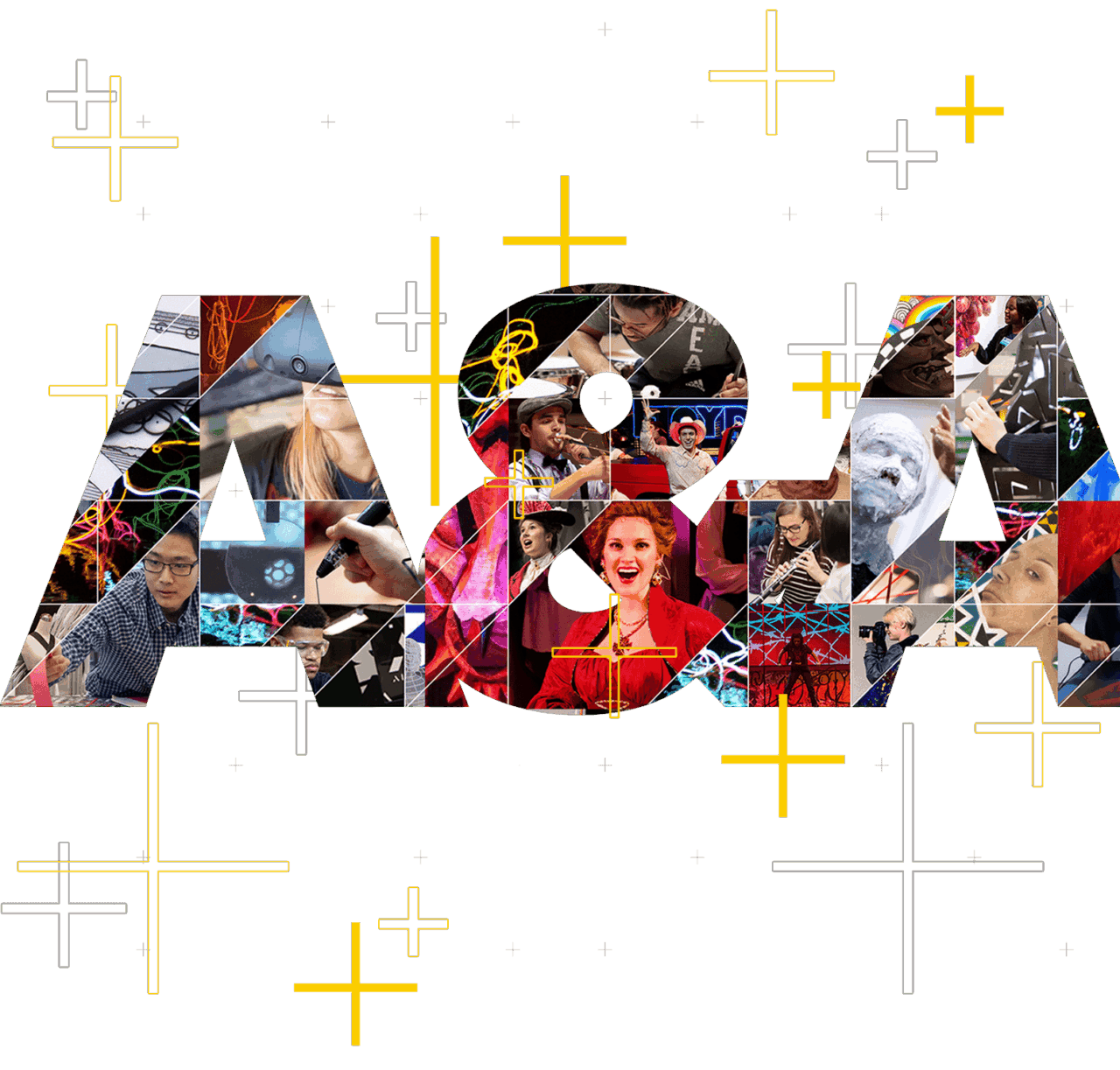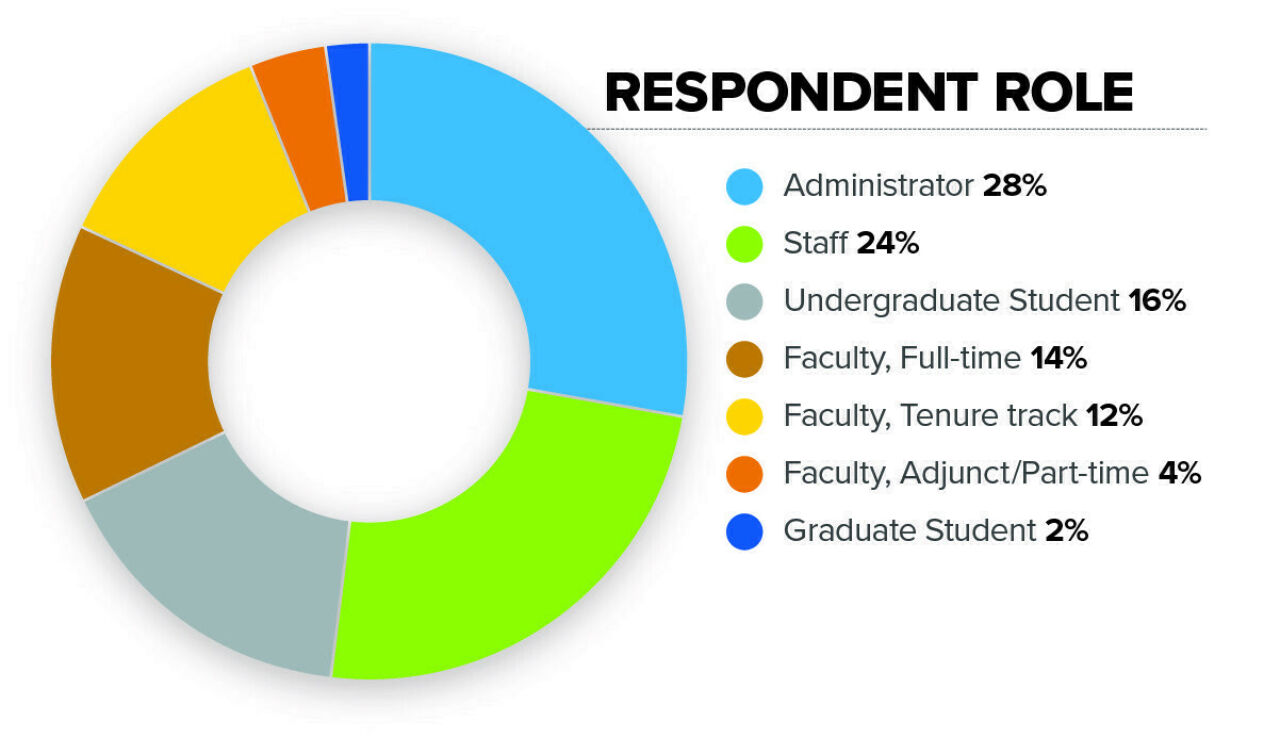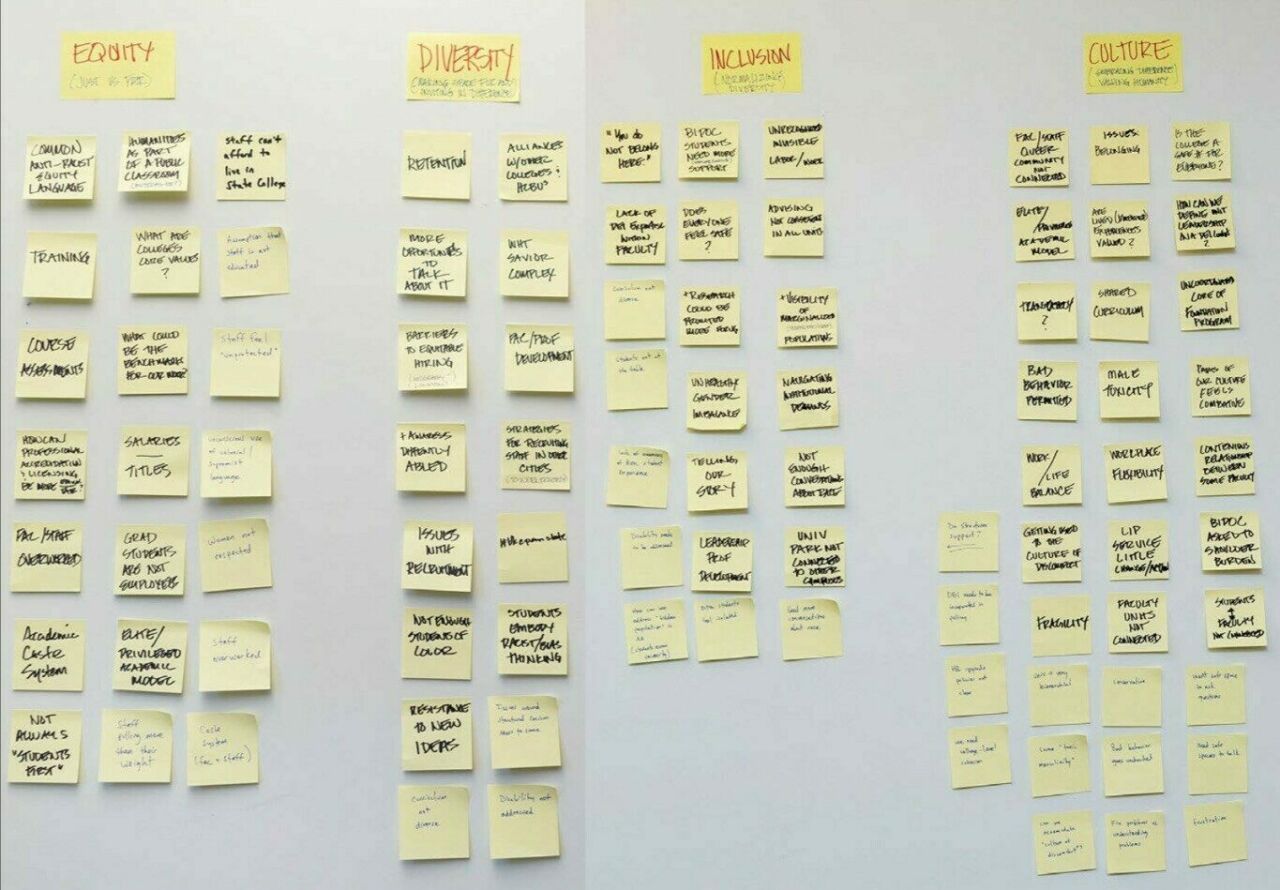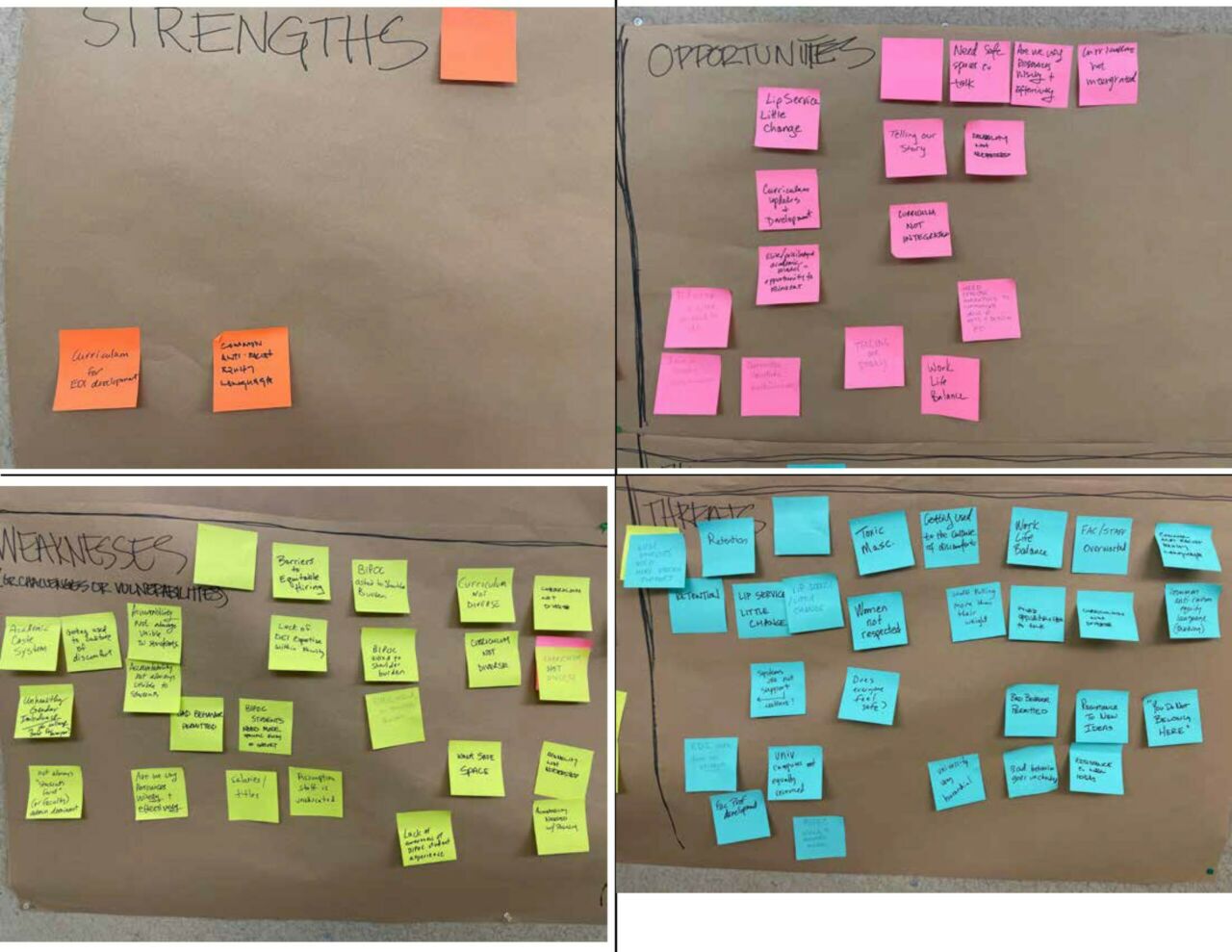A Report to the College of Arts and Architecture
by Folayemi Wilson, Associate Dean for Access and Equity
February 2022

- On this Page
- Process
- What I Heard
- Actions & Strategic Plan
- Conclusion
Introduction
As a new member of the College of Arts and Architecture and Penn State, I wanted to take time to learn about the culture of the college and its mission:
To prepare artists, designers, scholars, teachers, performers, and professional practitioners to further research and creative activity, and to interpret and preserve cultural heritage. We provide communities of the Commonwealth and beyond with performances, exhibitions, and arts engagement programs.”
My Fall 2021 listening tour initiated a period of listening as research about the culture of the College of Arts and Architecture and individual concerns regarding equity, diversity, inclusion and belonging. I spoke with more than 50 representatives of the college, including students, staff, faculty, college leadership and administration, as well as a few members of the university-at-large.
My role in this inaugural position is to lead with the cooperation and collective support of this community in realizing, among the others, one of four important college strategic goals to:
…establish a culture of anti-racism and anti-oppression that embraces individual identities, fosters a culture of inclusion and promotes equity through our curricula, values, standards, ideals, policies and practices.”
My Process
My first year in this role involves a three-phase process of groundwork, assessment and planning to lay the foundation for effective and sustainable action over a five-year period that creates meaningful and sustainable change as we learn increasingly effective practices towards equity. All of these phases overlap and are in relation to each other and will continue in subsequent years as specific actions are recommended and our work to this end is evaluated.
Phase One – Groundwork
- Listening to the concerns of various community members.
- Becoming familiar with the specifics of the strategic plan.
- Accessing what steps towards anti-racist and anti-oppressive policies, structures and culture have been taken so far.
- Determining what capacity the college has to move towards these goals.
- Understanding what equity, diversity, inclusion and belonging looks like to different students, faculty and staff.
Phase Two – Assessment
The central questions I am looking to answer in this phase are:
- What degree of awareness is there about anti-racism and anti-oppression in the various units in Arts and Architecture among faculty, students and staff?
- How committed is the college community to making meaningful change?
- What actions can be taken and what metrics need to change to make sustainable progress?
- What resources are there, or that can be developed, acquired and employed to support this work?
Phase Three – Planning
The first two phases will inform this one to a large degree. I am encouraged by the significant work that was done in Spring 2021 to identify specific and actionable items with timelines, accountability and measures of success as specified in the strategic plan. The above phases will help me to prioritize these proposals in a set of recommendations that take into account our capacity to achieve them and help us to gather the resources necessary to realize this work.
Who I listened to…
Penn State is a large and complex institution and my plan was not to try to take it in all at once, but to start with our college to obtain a foundational understanding of my academic home base and branch out to learn more about the University in relation to my work within the college over time.
Working with issues of equity in an academic setting can be challenging, as students, staff, faculty and administration often have experiences and see priorities related to access, equity, diversity, inclusion and belonging from various vantage points depending on their proximity to resources, power and individual agency. In establishing this position, my methodology is not to impose a predetermined set of actions as if there is a particular set of solutions that would work for every institution, but to suggest a path through on-the-ground, real-time assessments that meet this community where it is. My listening tour started this process.
I conducted individual one-on-one sessions between September and December 2021, with the college’s executive team, department heads and school directors, chairs and leaders of department ED&I committees, current and past representatives from the Faculty Council and the College Academic Leadership Council (CALC and CALC+), staff from the Center for the Performing Arts and the Palmer Museum, other staff from various areas of the college, undergraduate and graduate students from different departments, student diversity committees, and a few representatives from the university-at-large at University Park and other campuses.
My primary question that started these sessions was a broad one. Each person was asked to share with me their experiences and concerns around access, equity, diversity, inclusion and belonging – personally, through the area or unit they worked in, the college, or the University as a whole. They could answer the question and enter into the conversation any way they felt comfortable. I started by asking each of them to tell me how they came to Penn State and a little about their background and where they were from.


The Listening Tour: What I Heard…
Summarizing what I heard in response to my question about equity, diversity, inclusion, and belonging, consistent and recurring themes were:
accountability
curriculum (came up a lot)
need for education and training
invisibility/visibility
isolation
language
lack of proximity to difference
standards of respect
transparency
some systems, policies + culture are perceived as
not connected
not coordinated or
inconsistent
many folx feel
not included or that they do not belong
some folx
want to talk about it
others
want to take action
some
are exhausted
and some of our students feel we
are not listening.
The Good News
The majority of participants were hopeful and consistently felt the collective will is there for this work and overwhelmingly want to address issues of equity, diversity, inclusion and belonging. They want to see the college succeed in these areas. In our conversations, some offered ideas. Many had wonderful questions. Others did not know how we would get there.
More details
Noting dominate themes from each session, I distributed them among four main categories: equity, diversity, inclusion, and culture. Notes around structures and policies were put in a separate category, and I had a miscellaneous category for comments that did not fit neatly anywhere else, yet seemed important to note. I summarized the definitions in ways that reflected how the topics were discussed by listening tour participants:
- equity = normalizing diversity
- diversity = making space for and inviting in difference
- inclusion = just vs. fair? (as one participant questioned)
- culture = embracing difference and valuing our humanity
We talked about many things in various contexts. The following comments are aggregated, abbreviated and representative of feedback offered and shared among the participants. Selected singular comments you will find in quotes. Although many comments could fit in various categories, I put them in the category related to the context in which they were shared with me. They are in no particular order.


SWOT analysis
As I was assessing the sessions, I asked the college’s ED&I committee and a few guests for feedback and invited them into a SWOT analysis (Strengths/Weaknesses/ Opportunities/Threats) as part of the process. This methodology evolved from 1960s and 70s business strategy and has been adopted by various types of organizations as an evaluative tool.
The group reviewed Post-It notes of listening session comments from my office wall, chose some that resonated, and assigned them to the SWOT matrix. A few participants thought some comments could be converted into strengths. The majority of items ended up elsewhere – some in multiple categories. Some samples from our exercise follow.
Strengths
- common anti-racist/equity language
- curriculum for ED&I development
Weaknesses
- curriculum not diverse
- salaries/titles
- are we using resources wisely?
- not always “student-first”
- bad behavior permitted
- BIPOC asked to shoulder burden
- lack of DEI expertise within faculty
- academic “caste” system
- BIPOC students need more support
- getting used to the culture of discomfort
- perception staff is uneducated
- unhealthy gender balance
- accountability not visible to students
- curriculum not diverse
- barriers to equitable hiring
Opportunities
- lip service/little change
- common anti-racist language
- curriculum not integrated
- work–life balance
- need safe space to talk
- are we using resources wisely?
- telling our story
- elite/privileged academic model
Threats
- retention
- toxic masculinity
- work–life balance
- bad behavior permitted
- does everyone feel safe?
- faculty/staff overworked
- lip service/little change
- staff pulling more than their weight
- resistance to new ideas
- women not respected
- getting used to the culture of discomfort
- Penn State campuses not equally resourced
- faculty professional development
- “you do not belong here”
Recommended Action Plan SP22 + AY22-23
Establishing priorities
Welcoming diversity is most successful when there is a population who is educated about difference and the history of racism and oppression, and who can embrace the benefits that diversity brings. Although there are ongoing initiatives to bring more diversity into our student population through addressing barriers to access and opportunity, and new measures developed for search policies to diversify our faculty, we still have lots of work to do.
We can invite people in, and what will they find when they get here?
Retention of diverse populations of students, staff and faculty is hard to maintain without an underlying culture that is welcoming, responsive, supportive and willing to embrace difference. Institutions cannot simply rely on mechanisms of representation to achieve equity. Structures and policies that are intentional about dismantling structural racism must be elevated to the foreground, and accountability made visible in practice. Being educated about the history of racism and oppression and embracing difference as a key value can begin to build a foundation for a healthy community poised to manage the joys and challenges of change.
The good news here is that the college has already started down this path. What follows are recommendations that bring the college’s work together and some other suggestions that will take us deeper.
A&A Strategic Plan Goal #2: Establish a culture of anti-racism and anti-oppression that embraces individual identities, fosters a culture of inclusion, and promotes equity through our curricula, values, standards, ideals, policies, and practices.”
Goal #2 action items for SP22
Equity in Culture
Establish guidelines for meetings, gatherings, and publications to promote respectful, inclusive, and non-discriminatory discourse. (Action Item 2.1.4)
- Use of pronouns – develop recommendations for more consistent use by students, faculty and staff in email signatures, classrooms, presentations/lectures and on Zoom.
- Land acknowledgments – develop recommendations on when to use it, in what circumstances and examples of how to use it effectively and genuinely.
- Captioning and accommodations – recommendations for caption use in classrooms and other events.
- Protocols and guidelines for responding to national and local events – formalize and make sure everyone knows how this will happen and who is responsible for what, in what order, and what they can do.
Equity in Curricula
Objective #2.2: Uphold anti-racism and equitable standards and ideals within college curricula.
- Workshops/Trainings developed to support faculty in curricular (re)design towards inclusive content and pedagogy, and equitable classroom practices.
- Aggregate existing resources in a central place. Develop additional disciplinary-specific resources, introduce new workshops and trainings.
- Encourage and support interdisciplinary collaborations between departments and faculty.
Conduct an audit of college curricula to ensure anti-racist and equitable content is normalized. (Action item 2.2.1)
- Develop guidelines to help faculty evaluate courses and standards for developing new ones.
- Audit department/unit curricula. Work with deans and department heads to devise a plan to audit overall curricula.
- Start with First-Year Seminars and work our way up. An audit of FYS has been conducted by outside consultants.
Identify, revise, or develop at least one required course in each program to promote equity and inclusion. (Action Item 2.2.2)
- Determine if an appropriate course already exists, if one can be revised and redeveloped, or a new course created.
Develop an equity/racial ethics/integrity statement and require it to be included in all college syllabi. (Action Item 2.2.4 )
- Develop for Fall 2022 courses.
Equity in Programming
Objective #2.3: Increase anti-racist and equitable professional development, programs, collections, exhibitions, and performances.
Provide anti-racism/inclusion/equity/discrimination/implicit bias professional development for staff and faculty annually, as well as in new staff and faculty orientations. (Action Item 2.3.2)
- Limited professional development funds offered in 2020-21 by Office of Access and Equity with the intention of expanding the program.
- Provide multi-levels and dimensions of training and professional development
– Understanding structural racism (ex. ALARM, Crossroads)
– Cultural competency
– Unconscious bias
– Pedagogical/classroom methodology and practice
– Discipline-specific equity training
Support faculty and staff to further their understanding and knowledge of anti-racism and equity, and to aid in applying these ideals in their work and professional interactions. (Action Item 2.3.3)
- Develop equity glossary and media to aid in fostering a common language and knowledge about evolving nomenclature.
- Ongoing collection of resources. Create a home for them on new Office of Access and Equity website.
- Publicize and include faculty, student and staff research, creative work, events and publications in this collection.
Other equity issues + actions
Conclusion
We must be generous as we learn, and forgiving when we mess up. We must strengthen what is working, and let go, be flexible and reevaluate when we fail. We must be kind to each other, open to others’ experiences besides what we individually know, and be fastidious, curious and hungry learners. I hope we can all lean in, be radical listeners to ourselves and each other, and carry our courageous agreements into brave new spaces. Thank you!